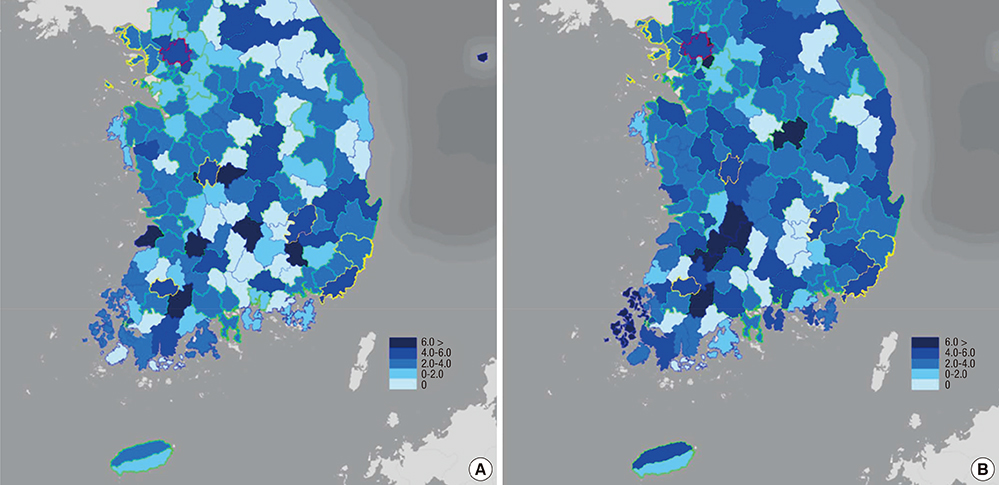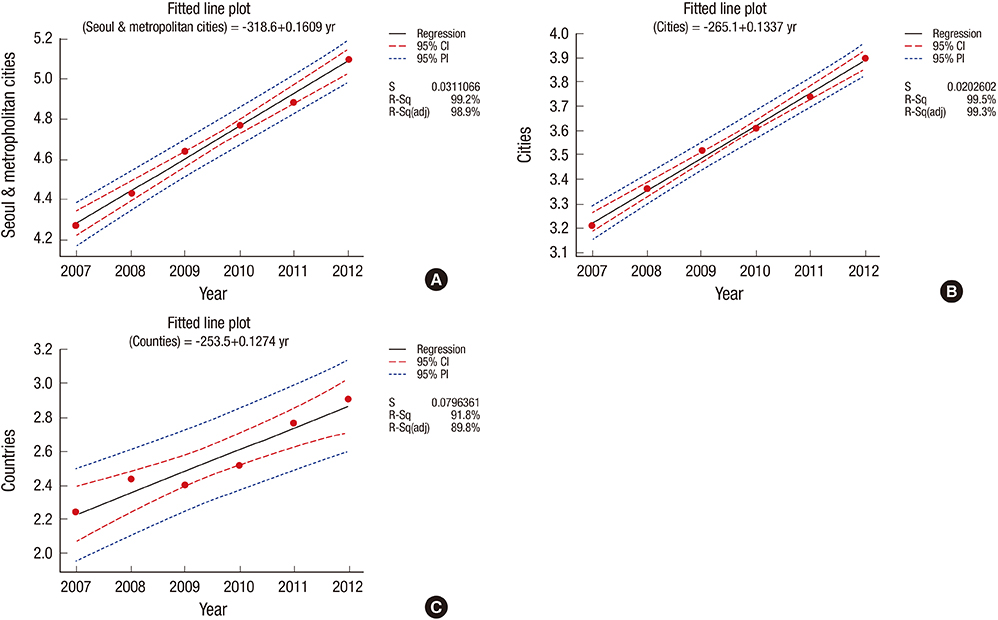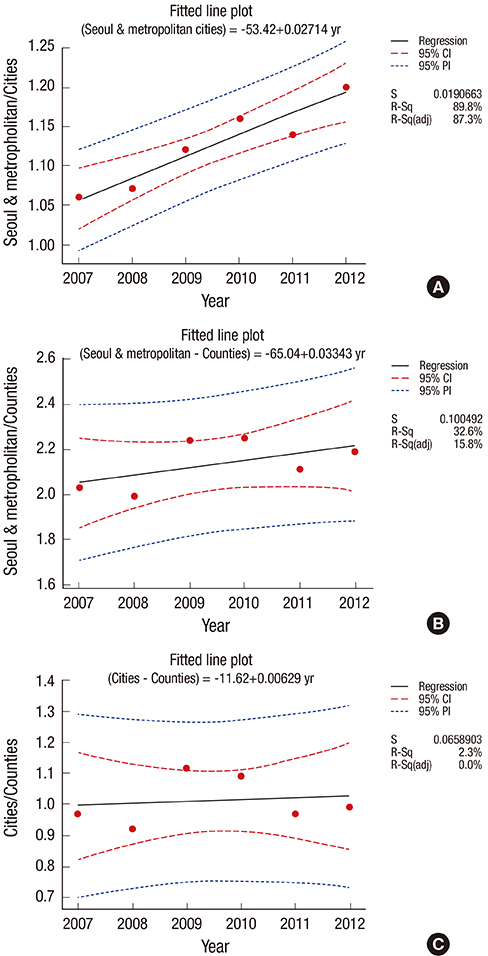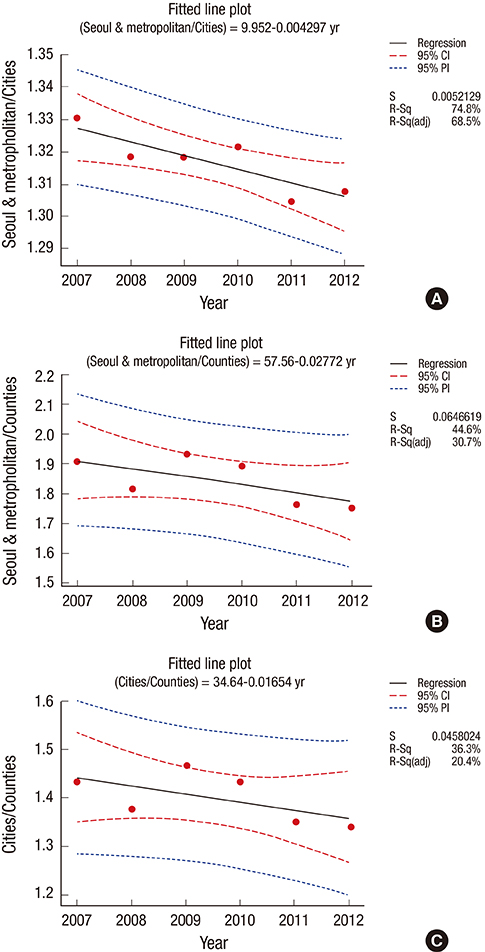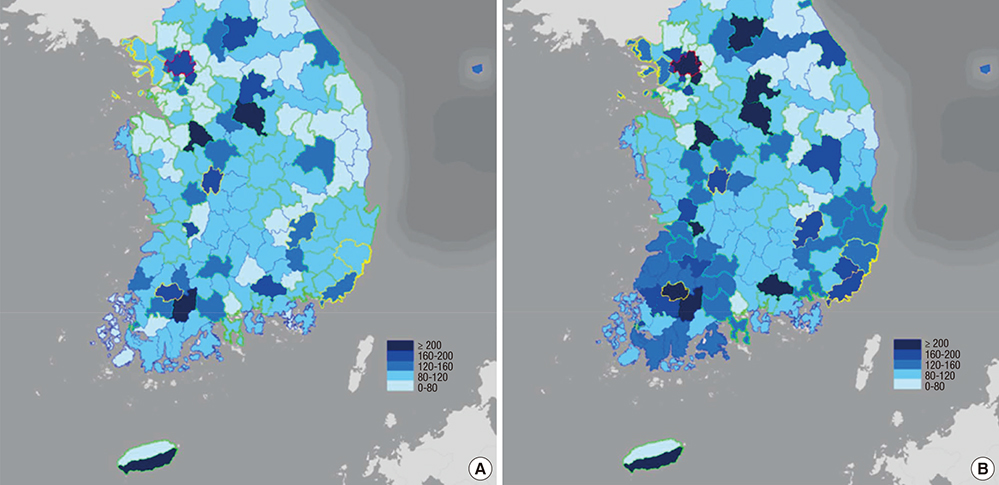J Korean Med Sci.
2015 Nov;30(11):1638-1645. 10.3346/jkms.2015.30.11.1638.
Geographic Distribution of Urologists in Korea, 2007 to 2012
- Affiliations
-
- 1Department of Urology, Soonchunhyang University Hospital, Soonchunhyang University College of Medicine, Seoul, Korea. piacekjh@hanmail.net
- 2Institute for Clinical Molecular Biology Research, Soonchunhyang University Hospital, Soonchunhyang University College of Medicine, Seoul, Korea.
- 3Department of Industrial and Management Engineering, Pohang University of Science and Technology, Pohang, Korea.
- 4Comparative Literature and Culture, Yonsei University, Underwood International College, Seoul, Korea.
- 5Department of Mathematics, College of Natural Science, Ajou University, Suwon, Korea.
- KMID: 2351115
- DOI: http://doi.org/10.3346/jkms.2015.30.11.1638
Abstract
- The adequacy of the urologist work force in Korea has never been investigated. This study investigated the geographic distribution of urologists in Korea. County level data from the National Health Insurance Service and National Statistical Office was analyzed in this ecological study. Urologist density was defined by the number of urologists per 100,000 individuals. National patterns of urologist density were mapped graphically at the county level using GIS software. To control the time sequence, regression analysis with fitted line plot was conducted. The difference of distribution of urologist density was analyzed by ANCOVA. Urologists density showed an uneven distribution according to county characteristics (metropolitan cities vs. nonmetropolitan cities vs. rural areas; mean square=102.329, P<0.001) and also according to year (mean square=9.747, P=0.048). Regression analysis between metropolitan and non-metropolitan cities showed significant difference in the change of urologists per year (P=0.019). Metropolitan cities vs. rural areas and non-metropolitan cities vs. rural areas showed no differences. Among the factors, the presence of training hospitals was the affecting factor for the uneven distribution of urologist density (P<0.001).Uneven distribution of urologists in Korea likely originated from the relatively low urologist density in rural areas. However, considering the time sequencing data from 2007 to 2012, there was a difference between the increase of urologist density in metropolitan and non-metropolitan cities.
Keyword
MeSH Terms
-
Cities/statistics & numerical data
Health Services Accessibility/*statistics & numerical data/trends
Korea/epidemiology
Physicians/*supply & distribution/trends
Republic of Korea/epidemiology
Rural Health Services/*manpower/statistics & numerical data/trends
Rural Population/statistics & numerical data/trends
Urban Health Services/*manpower/statistics & numerical data/trends
Urology/*manpower/*statistics & numerical data/trends
Figure
Cited by 1 articles
-
Infectious Diseases Physician Workforce in Korea
Youngeun Jang, Se Yoon Park, Bongyoung Kim, Eunjung Lee, Seungjae Lee, Hyo-Ju Son, Jung Wan Park, Shi Nae Yu, Tark Kim, Min Hyok Jeon, Eun Ju Choo, Tae Hyong Kim
J Korean Med Sci. 2020;35(49):e428. doi: 10.3346/jkms.2020.35.e428.
Reference
-
1. Starfield B, Shi L, Grover A, Macinko J. The effects of specialist supply on populations' health: assessing the evidence. Health Aff (Millwood). 2005; Suppl Web Exclusives:W5-97-W5-107.2. Shi L, Starfield B, Kennedy B, Kawachi I. Income inequality, primary care, and health indicators. J Fam Pract. 1999; 48:275–284.3. Goodman DC, Grumbach K. Does having more physicians lead to better health system performance? JAMA. 2008; 299:335–337.4. Van Durme DJ, Ullman R, Campbell RJ, Roetzheim R. Effects of physician supply on melanoma incidence and mortality in Florida. South Med J. 2003; 96:656–660.5. Basu K, Rajbhandary S. Interprovincial migration of physicians in Canada: What are the determinants? Health Policy. 2006; 76:186–193.6. Shi L, Starfield B. The effect of primary care physician supply and income inequality on mortality among blacks and whites in US metropolitan areas. Am J Public Health. 2001; 91:1246–1250.7. Rosenthal MB, Zaslavsky A, Newhouse JP. The geographic distribution of physicians revisited. Health Serv Res. 2005; 40:1931–1952.8. Horev T, Pesis-Katz I, Mukamel DB. Trends in geographic disparities in allocation of health care resources in the US. Health Policy. 2004; 68:223–232.9. Shi L, Macinko J, Starfield B, Wulu J, Regan J, Politzer R. The relationship between primary care, income inequality, and mortality in US States, 1980-1995. J Am Board Fam Pract. 2003; 16:412–422.10. Shi L, Macinko J, Starfield B, Politzer R, Xu J. Primary care, race, and mortality in US states. Soc Sci Med. 2005; 61:65–75.11. Ricketts TC, Holmes GM. Mortality and physician supply: does region hold the key to the paradox? Health Serv Res. 2007; 42:2233–2251.12. Odisho AY, Fradet V, Cooperberg MR, Ahmad AE, Carroll PR. Geographic distribution of urologists throughout the United States using a county level approach. J Urol. 2009; 181:760–765.13. Odisho AY, Cooperberg MR, Fradet V, Ahmad AE, Carroll PR. Urologist density and county-level urologic cancer mortality. J Clin Oncol. 2010; 28:2499–2504.14. Frye TP, Sadowski DJ, Zahnd WE, Jenkins WD, Dynda DI, Mueller GS, Alanee SR, McVary KT. Impact of county rurality and urologist density on urological cancer mortality in illinois. J Urol. 2015; 193:1608–1613.15. Grumbach K, Becker SH, Osborn EH, Bindman AB. The challenge of defining and counting generalist physicians: an analysis of Physician Masterfile data. Am J Public Health. 1995; 85:1402–1407.16. Lee JM, Davis MM, Menon RK, Freed GL. Geographic distribution of childhood diabetes and obesity relative to the supply of pediatric endocrinologists in the United States. J Pediatr. 2008; 152:331–336.17. Freed GL, Nahra TA, Wheeler JR. Research Advisory Committee of the American Board of Pediatrics. Relation of per capita income and gross domestic product to the supply and distribution of pediatricians in the United States. J Pediatr. 2004; 144:723–728.18. Hwang JH. Shortage of public healthcare personnel, is it a problem of number of doctors? J Korean Med Assoc. 2012; 55:812–814.19. Thompson MJ, Lynge DC, Larson EH, Tachawachira P, Hart LG. Characterizing the general surgery workforce in rural America. Arch Surg. 2005; 140:74–79.20. Rabinowitz HK, Diamond JJ, Markham FW, Wortman JR. Medical school programs to increase the rural physician supply: a systematic review and projected impact of widespread replication. Acad Med. 2008; 83:235–243.21. Chang CH, Stukel TA, Flood AB, Goodman DC. Primary care physician workforce and Medicare beneficiaries' health outcomes. JAMA. 2011; 305:2096–2104.
- Full Text Links
- Actions
-
Cited
- CITED
-
- Close
- Share
- Similar articles
-
- Empirical Analysis of Geographic Inequalities in the Distribution of Nurses
- Geographic Distribution of Central Nervous System Rehabilitation Treatment in Korea and Its Associated Factors
- Current status of female urologists in Korea
- Geographic information system (GIS) analysis on the distribution of patients visiting at a dental college hospital: a pilot study
- Comprehension and Practice Patterns of Korean Urologists for Retractile and Gliding Testes

